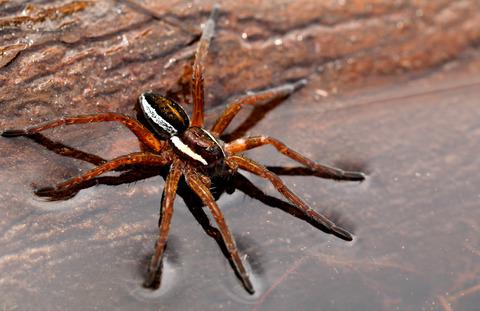当前位置:
X-MOL 学术
›
J. Anim. Ecol.
›
论文详情
Our official English website, www.x-mol.net, welcomes your
feedback! (Note: you will need to create a separate account there.)
Mate‐finding Allee effects can be exacerbated or relieved by sexual cannibalism
Journal of Animal Ecology ( IF 3.5 ) Pub Date : 2020-05-18 , DOI: 10.1111/1365-2656.13214 Adam M Fisher 1 , Stephen J Cornell 1 , Gregory I Holwell 2 , Tom A R Price 1
Journal of Animal Ecology ( IF 3.5 ) Pub Date : 2020-05-18 , DOI: 10.1111/1365-2656.13214 Adam M Fisher 1 , Stephen J Cornell 1 , Gregory I Holwell 2 , Tom A R Price 1
Affiliation

|
Allee effects occur when individual or population survival decreases due to populations being small or sparse. A key mechanism underlying Allee effects is difficulty in finding mates at low densities. Species may be particularly vulnerable to mate-finding Allee effects if females rely on an abundance of males to reproduce successfully. In sexually cannibalistic species, females may consume males before or after copulation, potentially reducing the supply of males to the point where a mate-finding Allee effect occurs. In this study, we investigate the extent to which sexual cannibalism can modulate mate-finding Allee effects, and the conditions under which sexual cannibalism is likely to be particularly detrimental to population viability. We created an individual-based model that tracked specific females throughout the breeding season and used extinction risk and per capita growth rate to measure the strength of the Allee effects. We varied both founder population size and mate encounter rate independently of each other to expose the mechanism driving the Allee effects. We also analysed how cannibalism-derived female fecundity benefits affected extinction risk. We found that sexual cannibalism could lead to high extinction risk, particularly when cannibalism occurred before copulation, founder population size was small and mate encounter rates were low. However, post-copulatory cannibalism reduced extinction risk, if cannibalism increased female fecundity enough. We found that there were strong threshold effects, in which small changes in encounter rate could strongly alter population extinction risk. We find that sexual cannibalism is likely to negatively impact population survival as population size and mate encounter rate decrease. This may be exacerbated if male quality declines and female hunger increases in declining populations. As many top invertebrate predators, such as spiders and mantises, are sexually cannibalistic, this may have ecosystem-wide impacts. We also suggest that other reproductive behaviours, such as rejecting all but high-quality mates or requiring multiple mates to ensure fertility, are also likely to cause mate-finding Allee effects when habitat quality degrades.
中文翻译:

性同类相食会加剧或缓解寻找伴侣的 Allee 效应
Allee 效应发生在个体或种群存活率因种群小或稀少而下降时。Allee 效应背后的一个关键机制是难以在低密度下找到配偶。如果雌性依赖大量雄性来成功繁殖,物种可能特别容易受到寻找配偶的 Allee 效应的影响。在性同类相食的物种中,雌性可能会在交配之前或之后吃掉雄性,这可能会导致雄性的供应减少到发生寻找配偶的 Allee 效应的程度。在这项研究中,我们调查了性同类相食在多大程度上可以调节寻找配偶的 Allee 效应,以及性同类相食可能对种群生存能力特别有害的条件。我们创建了一个基于个体的模型,该模型在整个繁殖季节跟踪特定雌性,并使用灭绝风险和人均增长率来衡量 Allee 效应的强度。我们独立地改变了创始人人口规模和配偶相遇率,以揭示驱动 Allee 效应的机制。我们还分析了自相残杀的雌性生育优势如何影响灭绝风险。我们发现性同类相食可能导致高灭绝风险,特别是当同类相食发生在交配之前,创始人种群规模较小且偶遇率较低时。然而,交配后的同类相食降低了灭绝的风险,如果同类相食增加了雌性的生育能力就足够了。我们发现有很强的阈值效应,其中遭遇率的微小变化可能会强烈改变种群灭绝风险。我们发现,随着人口规模和交配率下降,性同类相食可能会对人口生存产生负面影响。如果在人口减少的情况下男性素质下降而女性饥饿增加,这种情况可能会加剧。由于许多顶级无脊椎动物捕食者,如蜘蛛和螳螂,都是性同类相食的,这可能会对整个生态系统产生影响。我们还建议,当栖息地质量下降时,其他生殖行为,例如拒绝除高质量配偶之外的所有配偶或需要多个配偶以确保生育能力,也可能导致寻找配偶的 Allee 效应。如果在人口减少的情况下男性素质下降而女性饥饿增加,这种情况可能会加剧。由于许多顶级无脊椎动物捕食者,如蜘蛛和螳螂,都是性同类相食的,这可能会对整个生态系统产生影响。我们还建议,当栖息地质量下降时,其他生殖行为,例如拒绝除高质量配偶之外的所有配偶或需要多个配偶以确保生育能力,也可能导致寻找配偶的 Allee 效应。如果在人口减少的情况下男性素质下降而女性饥饿增加,这种情况可能会加剧。由于许多顶级无脊椎动物捕食者,如蜘蛛和螳螂,都是性同类相食的,这可能会对整个生态系统产生影响。我们还建议,当栖息地质量下降时,其他生殖行为,例如拒绝除高质量配偶之外的所有配偶或需要多个配偶以确保生育能力,也可能导致寻找配偶的 Allee 效应。
更新日期:2020-05-18
中文翻译:

性同类相食会加剧或缓解寻找伴侣的 Allee 效应
Allee 效应发生在个体或种群存活率因种群小或稀少而下降时。Allee 效应背后的一个关键机制是难以在低密度下找到配偶。如果雌性依赖大量雄性来成功繁殖,物种可能特别容易受到寻找配偶的 Allee 效应的影响。在性同类相食的物种中,雌性可能会在交配之前或之后吃掉雄性,这可能会导致雄性的供应减少到发生寻找配偶的 Allee 效应的程度。在这项研究中,我们调查了性同类相食在多大程度上可以调节寻找配偶的 Allee 效应,以及性同类相食可能对种群生存能力特别有害的条件。我们创建了一个基于个体的模型,该模型在整个繁殖季节跟踪特定雌性,并使用灭绝风险和人均增长率来衡量 Allee 效应的强度。我们独立地改变了创始人人口规模和配偶相遇率,以揭示驱动 Allee 效应的机制。我们还分析了自相残杀的雌性生育优势如何影响灭绝风险。我们发现性同类相食可能导致高灭绝风险,特别是当同类相食发生在交配之前,创始人种群规模较小且偶遇率较低时。然而,交配后的同类相食降低了灭绝的风险,如果同类相食增加了雌性的生育能力就足够了。我们发现有很强的阈值效应,其中遭遇率的微小变化可能会强烈改变种群灭绝风险。我们发现,随着人口规模和交配率下降,性同类相食可能会对人口生存产生负面影响。如果在人口减少的情况下男性素质下降而女性饥饿增加,这种情况可能会加剧。由于许多顶级无脊椎动物捕食者,如蜘蛛和螳螂,都是性同类相食的,这可能会对整个生态系统产生影响。我们还建议,当栖息地质量下降时,其他生殖行为,例如拒绝除高质量配偶之外的所有配偶或需要多个配偶以确保生育能力,也可能导致寻找配偶的 Allee 效应。如果在人口减少的情况下男性素质下降而女性饥饿增加,这种情况可能会加剧。由于许多顶级无脊椎动物捕食者,如蜘蛛和螳螂,都是性同类相食的,这可能会对整个生态系统产生影响。我们还建议,当栖息地质量下降时,其他生殖行为,例如拒绝除高质量配偶之外的所有配偶或需要多个配偶以确保生育能力,也可能导致寻找配偶的 Allee 效应。如果在人口减少的情况下男性素质下降而女性饥饿增加,这种情况可能会加剧。由于许多顶级无脊椎动物捕食者,如蜘蛛和螳螂,都是性同类相食的,这可能会对整个生态系统产生影响。我们还建议,当栖息地质量下降时,其他生殖行为,例如拒绝除高质量配偶之外的所有配偶或需要多个配偶以确保生育能力,也可能导致寻找配偶的 Allee 效应。










































 京公网安备 11010802027423号
京公网安备 11010802027423号